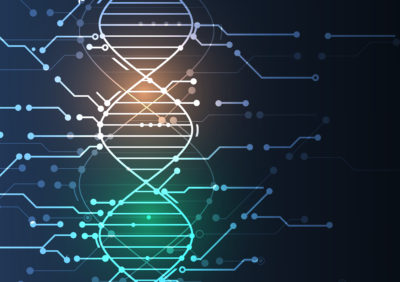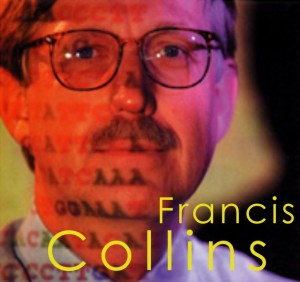 The junk DNA theory was introduced in 1972 by evolutionary geneticist Susumu Ohno in the paper entitled “So Much ‘Junk’ in Our Genome.”
The junk DNA theory was introduced in 1972 by evolutionary geneticist Susumu Ohno in the paper entitled “So Much ‘Junk’ in Our Genome.”
The junk comprises sections in the genome with no discernible function, it was thought. Previously, in 1970, Ohno gained notoriety for his gene duplication-driven theory, presented in his book, Evolution by Gene Duplication.
In the highly acclaimed book, The Language of God (2006), geneticist Francis Collins endorsed Ohno’s theory of junk DNA. For Collins, junk DNA lent “powerful support for Darwin‘s theory of evolution.” As director of the National Center for Human Genome Research at the time, Collins gave immense credibility to Ohno’s junk DNA and gene-duplication theories.
Francis Collins
As a Washington, DC insider, Collins received numerous awards and honors, including election to the Institute of Medicine and the National Academy of Sciences. He was a Kilby International Awards recipient in 1993. In 2007, he was presented with the Presidential Medal of Freedom. And in 2008, he was awarded the National Medal of Science.
In 2009, Collins became Director of the National Institutes of Health and was appointed by Pope Benedict XVI to the Pontifical Academy of Sciences. With a $2 million grant from the Templeton Foundation, Collins co-founded the BioLogos Foundation in San Diego, California, to advance the concept of theistic evolution or evolutionary creation. Collins brings influence into the spheres of science and religion.
For Collins, junk DNA provided support for Darwin’s theory of evolution. These “ancient repetitive elements” were the vestiges of evolution, it seemed. As Collins explains in The Language of God –
“Darwin’s theory predicts that mutations that do not affect function (namely, those located in “junk DNA”) will accumulate steadily over time.”
The credibility of junk DNA critics, however, was questionable given the limited understanding of DNA until recently.
ENCODE
Investigations to better understand the nature of DNA have slowly revealed some of life’s secrets. Since 2006, an international consortium of 442 scientists began studying 147 different types of cells with 24 types of experiments. Within each genome, each nucleotide was documented.
This consortium project, launched in 2003 and funded by the National Human Genome Research Institute (NHGRI), was named ENCODE (Encyclopedia of DNA Elements). By 2007, however, Rick Weiss, writing for the Washington Post on the emerging ENCODE developments, reported –
“For the first time, the vast majority of the 3 billion ‘letters’ of the human genetic code are [known] busily toiling at an array of previously invisible tasks.”
Weiss was reporting on the study published in the journal Nature by Erika Hayden. According to Hayden, rather than junk, “between 74% to 93% of DNA” had evidence of performing biological functions.
Earlier this month, the consortium published its long-awaited findings. In the 30 papers published in multiple journals, a greater understanding of DNA functions emerged. These publications, including six in Nature, six in Genome Biology, and a special issue with 18 papers in Genome Research, demonstrated the stunning discovery that more than 80% of the human genome examined to date has a known biological function − not junk DNA.
Collins Ditches Junk DNA
Collins’s new book, entitled The Language of Life (2011), upends his once-popular “junk DNA” thinking –
“The discoveries of the past decade, little known to most of the public, have completely overturned much of what used to be taught in high school biology. If you thought the DNA molecule comprised thousands of genes but far more ‘junk DNA,’ think again.”
Junk DNA is now known not to be junk after all. Collins explains, now –
“These regions are not just filler, however. They contain many of the signals that are needed to instruct a nearby gene about whether it should be on or off at a given developmental time in a given tissue.”
Collins’s toss of “Junk DNA” is analogous to Darwin’s natural selection toss – intensifying Darwin’s dilemma.
Pseudogenes
Evolutionary biologists Evgeniy Balakirev and Francisco Ayala (pictured left) of the University of California, Irvine, however, in the article “Pseudogenes, Are They ‘Junk’ or Functional DNA” (2003) published in the Annual Review  of Genetics, reported –
of Genetics, reported –
“[The] pseudogenes that have been suitably investigated often exhibit functional roles.”
More recently, Ryan Pinkin and colleagues 2011, in the article “Pseudogenes: Pseudofunction or Key Regulators in Health and Disease” in the journal RNA, paint a clearer picture –
“Pseudogenes have long been labeled as ‘junk’ DNA, failed copies of genes that arise during the evolution of genomes. However, recent results are challenging this moniker; indeed, some pseudogenes appear to harbor the potential to regulate their protein-coding cousins. Far from being silent relics, many pseudogenes are transcribed into RNA, some exhibiting a tissue-specific pattern of activation.”
Given the new DNA evidence, Collins updated his junk-DNA approach in his most recent book, The Language of Science and Faith (2011), by focusing on pseudogenes – noncoding DNA.
The genome revolution has upended Ohno’s once-popular “So Much ‘Junk’ in Our Genome” and gene-duplication theories. How noncoding DNA segments relate to the theory of evolution remains purely speculative.
Genesis
Nature’s story, while estranged from Darwin’s theory, continues to be compatible with the Genesis account written by Moses.
Nicholas Copernicus (pictured right). a Renaissance mathematician and astronomer proposed that Earth rotates around the Sun. The theory, known as a heliocentric theory, eventually upended the once widely accepted geocentric model. While highly controversial at the time, importantly, Copernicus’s model has been scientifically validated. As Copernicus explains during the Scientific Revolution –
“The mechanisms of the universe, wrought for us by a supremely good and orderly Creator… the system best and most orderly artist of all framed for our sake.”
Evidence from molecular biology underscores why the theory of evolution remains speculative but not scientifically valid.
Junk DNA Theory is a Molecular Biology article.
Darwin Then and Now is an educational resource on the intersection of evolution and science, highlighting the ongoing challenges to the theory of evolution.
Move On
Explore how to understand twenty-first-century concepts of evolution further using the following links –
-
- The Understanding Evolution category showcases how varying historical study approaches to evolution have led to varying conclusions. Subcategories include –
- Studying Evolution explains how key evolution terms and concepts have changed since the 1958 publication of The Origin of Species.
- What is Science explains Charles Darwin’s approach to science and how modern science approaches can be applied for different investigative purposes.
- Evolution and Science feature study articles on how scientific evidence influences the current understanding of evolution.
- Theory and Consensus feature articles on the historical timelines of the theory and Natural Selection.
- The Biography of Charles Darwin category showcases relevant aspects of his life.
- The Glossary defines terms used in studying the theory of biological evolution.
- The Understanding Evolution category showcases how varying historical study approaches to evolution have led to varying conclusions. Subcategories include –
2020 Update
WIKIPEDIA, 2020
“About 95% of the human genome has once been designated as ‘junk,’ including most sequences within introns and most intergenic DNA. While much of this sequence may be an evolutionary artifact that serves no present-day purpose, some junk DNA may function in ways that are not currently understood. Moreover, the conservation of some junk DNA over many millions of years of evolution may imply an essential function. Some consider the “junk” label as something of a misnomer, but others consider it appropriate, as junk is stored away for possible new uses rather than thrown out; others prefer the term “noncoding DNA” (although junk DNA often includes transposons that encode proteins with no clear value to their host genome). About 80% of the bases in the human genome may be transcribed, but transcription does not necessarily imply function.”
“Noncoding DNA sequences are components of an organism’s DNA that do not encode protein sequences. Some noncoding DNA is transcribed into functional noncoding RNA molecules (e.g., transfer RNA, ribosomal RNA, and regulatory RNAs). Other functions of noncoding DNA include the transcriptional and translational regulation of protein-coding sequences, scaffold attachment regions, origins of DNA replication, centromeres, and telomeres…. Noncoding DNA is involved in epigenetic activity and complex networks of genetic interactions.”
Evolution 101, 2020
“So, just to review, the majority of a genome (at least, the human genome) is noncoding sequence. Some of this noncoding sequence is truly junk, as in the case with transposons, pseudogenes, etc., and some of it is important for proper genetic expression. It’s not all junk, but it’s not all gold, either.” Last update 2006.
Smithsonian, 2020
“Remember in high school or college, when you learned about all that DNA inside of you that was junk? The strings and strings of nonsense code that had no function? A recent blitz of papers from the ENCODE project has the world abuzz with news that would rip that idea apart.” Last update 2012.



